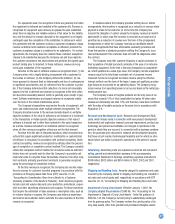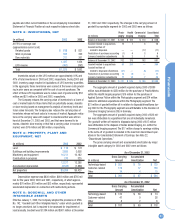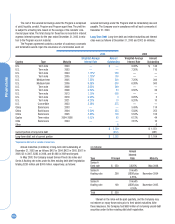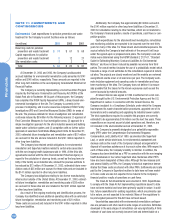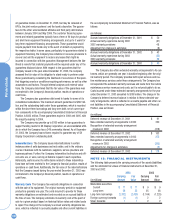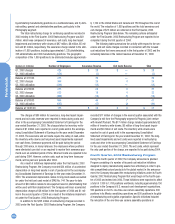Kodak 2003 Annual Report Download - page 56
Download and view the complete annual report
Please find page 56 of the 2003 Kodak annual report below. You can navigate through the pages in the report by either clicking on the pages listed below, or by using the keyword search tool below to find specific information within the annual report.
Financials
56
NOTE 11: COMMITMENTS AND
CONTINGENCIES
Environmental Cash expenditures for pollution prevention and waste
treatment for the Company’s current facilities were as follows:
(in millions) 2003 2002 2001
Recurring costs for pollution
prevention and waste treatment $ 74 $ 67 $ 68
Capital expenditures for pollution
prevention and waste treatment 812 27
Site remediation costs 232
Total $ 84 $ 82 $ 97
At December 31, 2003 and 2002, the Company’s undiscounted
accrued liabilities for environmental remediation costs amounted to $141
million and $148 million, respectively. These amounts are reported in the
other long-term liabilities in the accompanying Consolidated Statement of
Financial Position.
The Company is currently implementing a Corrective Action Program
required by the Resource Conservation and Recovery Act (RCRA) at the
Kodak Park site in Rochester, NY. As part of this program, the Company
has completed the RCRA Facility Assessment (RFA), a broad-based envi-
ronmental investigation of the site. The Company is currently in the
process of completing, and in some cases has completed, RCRA Facility
Investigations (RFI) and Corrective Measures Studies (CMS) for areas at
the site. The previous estimate for future investigation and remediation
costs was reduced by $8 million for the following reasons: (1) approval of
Final Corrective Measures for four investigation areas, (2) approval for a
single investigation approach for the site’s industrial sewers and building
waste water collection system, and (3) completion with no further action
approvals at seventeen Solid Waste Management Units. At December 31,
2003, estimated future investigation and remediation costs of $57 million
are accrued for this site and are included in the $141 million reported in
other long-term liabilities.
The Company has retained certain obligations for environmental
remediation and Superfund matters related to certain sites associated
with the non-imaging health businesses sold in 1994. At the Ohio site,
agreements reached with the Ohio Environmental Protection Agency in
regard to the calculation of clean-up levels, as well as the long term via-
bility of the facility as an industrial site, allowed the previous estimate to
be reduced by $13 million. At December 31, 2003, estimated future reme-
diation costs of $35 million are accrued for these sites and are included in
the $141 million reported in other long-term liabilities.
The Company has obligations relating to two former manufacturing
sites located outside of the United States. At December 31, 2003, estimat-
ed future investigation, remediation and monitoring costs of $20 million
are accrued for these sites and are included in the $141 million reported
in other long-term liabilities.
As a result of the ongoing monitoring and identification process, the
Company has identified seven additional operating sites with an estimated
future investigation, remediation and monitoring cost of $21 million.
These costs are accrued and included in the $141 million reported in other
long-term liabilities.
Additionally, the Company has approximately $8 million accrued in
the $141 million reported in other long-term liabilities at December 31,
2003 for remediation relating to other facilities, which are not material to
the Company’s financial position, results of operations, cash flows or com-
petitive position.
Cash expenditures for the aforementioned investigation, remediation
and monitoring activities are expected to be incurred over the next thirty
years for many of the sites. For these known environmental exposures, the
accrual reflects the Company’s best estimate of the amount it will incur
under the agreed-upon or proposed work plans. The Company’s cost esti-
mates were determined using the ASTM Standard E 2137-01, “Standard
Guide for Estimating Monetary Costs and Liabilities for Environmental
Matters,” and have not been reduced by possible recoveries from third
parties. The overall method includes the use of a probabilistic model which
forecasts a range of cost estimates for the remediation required at individ-
ual sites. The projects are closely monitored and the models are reviewed
as significant events occur or at least once per year. The Company’s esti-
mate includes equipment and operating costs for remediation and long-
term monitoring of the sites. The Company does not believe it is reason-
ably possible that the losses for the known exposures could exceed the
current accruals by material amounts.
A Consent Decree was signed in 1994 in settlement of a civil com-
plaint brought by the U.S. Environmental Protection Agency and the U.S.
Department of Justice. In connection with the Consent Decree, the
Company is subject to a Compliance Schedule, under which the Company
has improved its waste characterization procedures, upgraded one of its
incinerators and is evaluating and upgrading its industrial sewer system.
The total expenditures required to complete this program are currently
estimated to be approximately $16 million over the next five years. These
expenditures are incurred as part of plant operations and, therefore, are
not included in the environmental accrual at December 31, 2003.
The Company is presently designated as a potentially responsible
party (PRP) under the Comprehensive Environmental Response,
Compensation, and Liability Act of 1980, as amended (the Superfund
Law), or under similar state laws, for environmental assessment and
cleanup costs as the result of the Company’s alleged arrangements for
disposal of hazardous substances at four such active sites. With respect to
each of these sites, the Company’s liability is minimal. In addition, the
Company has been identified as a PRP in connection with the non-imaging
health businesses in four active Superfund sites. Numerous other PRPs
have also been designated at these sites. Although the law imposes joint
and several liability on PRPs, the Company’s historical experience demon-
strates that these costs are shared with other PRPs. Settlements and costs
paid by the Company in Superfund matters to date have not been materi-
al. Future costs are also not expected to be material to the Company’s
financial position, results of operations or cash flows.
The Clean Air Act Amendments were enacted in 1990. Expenditures
to comply with the Clean Air Act implementing regulations issued to date
have not been material and have been primarily capital in nature. In addi-
tion, future expenditures for existing regulations, which are primarily capi-
tal in nature, are not expected to be material. Many of the regulations to
be promulgated pursuant to this Act have not been issued.
Uncertainties associated with environmental remediation contingen-
cies are pervasive and often result in wide ranges of outcomes. Estimates
developed in the early stages of remediation can vary significantly. A finite
estimate of cost does not normally become fixed and determinable at a



